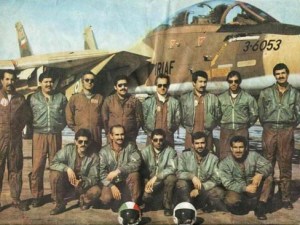Earlier this week, Congress learned U.S. arms sales around the world fell by nearly half from 2008 to 2009 — from $38.1 billion to $22.6 billion. Apparently the world’s flagging economy affects air forces and ministries of defence just as much as it does Main Street car dealers and hardware stores. But taking some of the edge off that gloomy economic news was the flash — likely inflated, but still eye-watering — that Saudi Arabia wants to buy up to $60 billion in U.S. arms over the coming decade.

Saudi F-15 at a recent wargame/DoD photo
It’s likely to end up the biggest U.S. arms sale ever, trigger additional purchases by nervous neighbors in the Middle East, and ensure continued U.S. arms sales to Israel (which is already in line to buy hotter warplanes than the Saudis are slated to get). “We will sell Saudi Arabia F-15 fighter jets, Apache and Black Hawk helicopters,” Jay Leno noted Monday in his Tonight Show monologue, “and many other weapons that will one day be used against us.”
While the joke may not have gone over well in Riyadh, Leno was referring to the gusher of weaponry, including front-line Grumman F-14 fighters outfitted with Hughes Phoenix air-to-air missiles, that Washington sold to Iran in the 1970s under Mohammad Reza Shah Pahlavi, the shah of Iran. That’s fitting, because much of the arms-buying now underway in the Middle East is because of concerns over Tehran’s suspected push for nuclear weapons. “They used to be most afraid of us,” an Israeli official says. “Now they’re more scared of Iran.”
The Obama Administration has yet to send a formal announcement of the sale to Congress, which then has 30 days to block the sale or allow it to proceed by doing nothing (which is expected in this case). The deal could include as many as 84 new F-15 fighters, improvements to 70 F-15s the Saudis already have, and three types of helicopters: 70 AH-64 Apache gunships, 72 UH-60 Black Hawk troop-carriers, and 36 MH-6 Little Bird observation aircraft. But those numbers aren’t as important as the economic punch such a sale would pack back home: Boeing, which builds the F-15s, Apaches and Little Birds, estimates the sale would preserve or create some 75,000 jobs across 44 states. Sales of naval vessels and missile-defense networks could boost the total value of the sale by tens of billions of dollars.
Not coincidentally, those are the very kinds of weapons the Gulf Cooperation Council — Iran’s neighbors, including Saudi Arabia and Kuwait — want to buy, says this week’s Congressional Research Service study of the international arms trade. “Concerns over the growing strategic threat from Iran, which have continued in the 21st century, have become the principal basis of GCC states’ advanced arms purchases,” says the report, by longtime CRS arms-sales analyst Richard Grimmett. “Because GCC states do not share a land border with Iran, their weapons purchases have focused primarily on air, naval, and missile defense systems.” Arms-trade experts consider the annual report as the most comprehensive unclassified accounting of global arms sales available.
“Large as these (Saudi) arms transfers may seem, it is important to understand that the weapons numbers involved are relatively limited, given the overall size of forces in the (Persian) Gulf,” Anthony Cordesman of the Center for Strategic and International Studies noted Tuesday. “They meet key Saudi concerns in force expansion and modernization, provide the basis for full interoperability with U.S. forces in a crisis or conflict, and give Saudi Arabia a significant `edge’ in air superiority against Iran.” But some observers were more skeptical. “The $60 billion arms deal with Saudi Arabia is mostly about money,” says William Hartung, an arms-sale analyst with the New American Foundation. “It’s a huge shot in the arm for U.S. defense contractors at a time when Pentagon spending is leveling off. For the Saudis, it has more to do with buying favor in Washington than it does with assembling a coherent military force.”
The U.S. accounted for $22.6 billion in arms sales last year, 39 cents of every dollar spent on the international arms trade, the CRS study says. More than $17 billion of those sales, about 80 percent, was to developing nations such as Egypt, Kuwait, Saudi Arabia, Taiwan and the United Arab Emirates.

An Iranian F-14/Paul Iddon blog
Israel has monitored the Saudi transaction closely, and has been assured by Washington it will contain no surprises. “We’re not thrilled by the Saudi deal,” an Israeli government official says, “but we can live with it because there’s a clear commitment [by Washington] to maintain Israel’s QME” — qualitative military edge.
That’s why Israel is readying its initial request for 20 Lockheed F-35s, the Pentagon’s newest and hottest fighter, for about $2.5 billion. U.S. taxpayers will likely pay for much of the purchase given the nearly $3 billion in military aid the U.S. gives to Israel each year. The Saudis largely fund their weapons purchases themselves with oil revenues, including the more than $2 billion U.S. drivers pay for oil imports from the desert kingdom every month. One way or another, it seems, we’re paying for both sides. At least we’re not arming the Iranians anymore.


